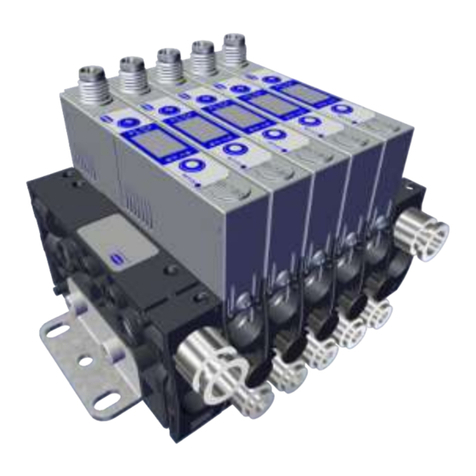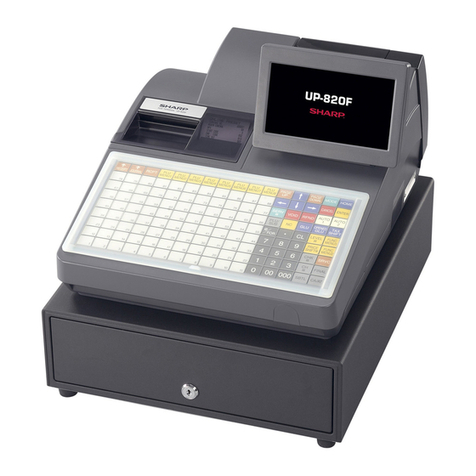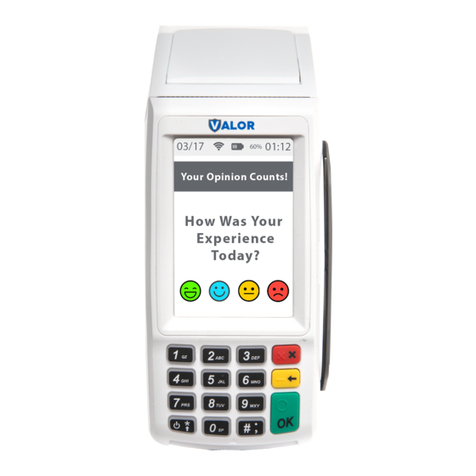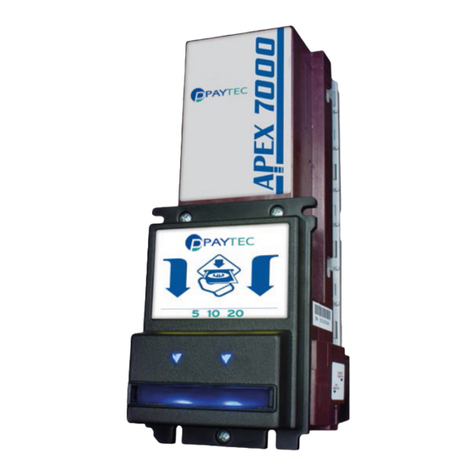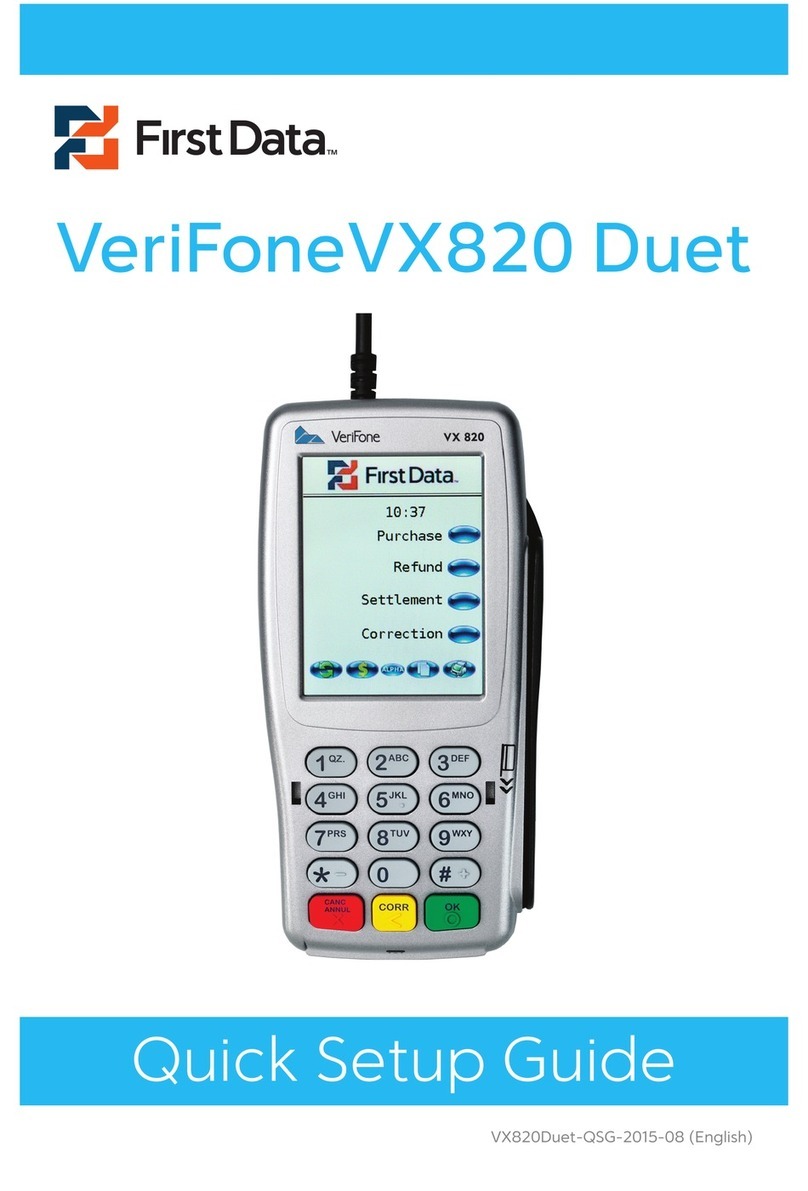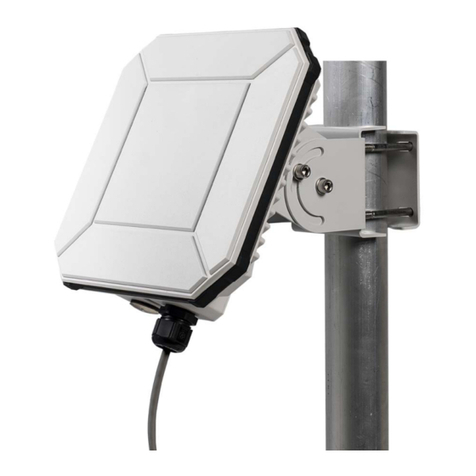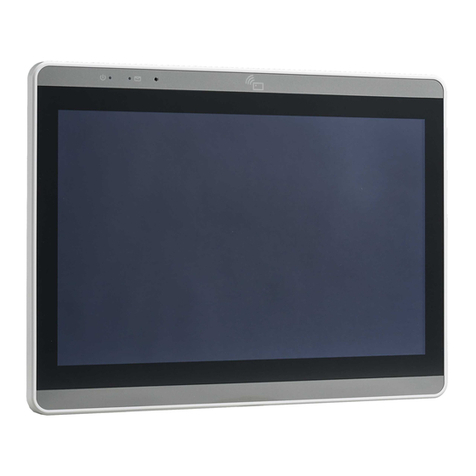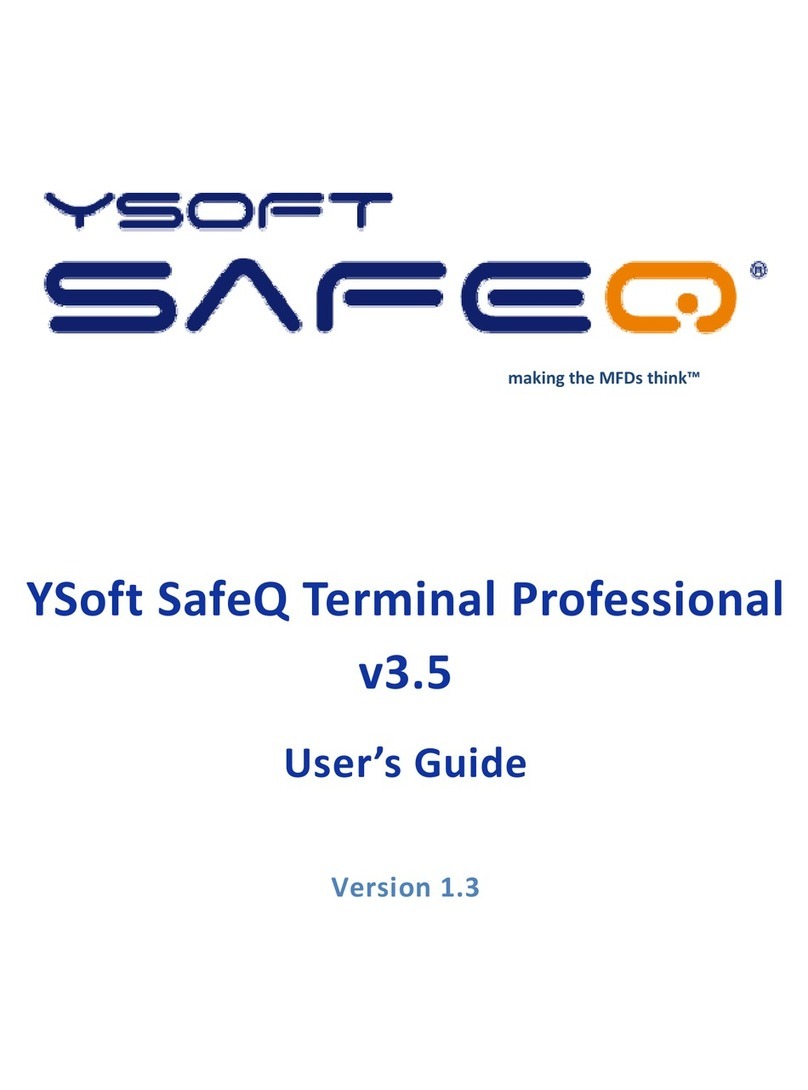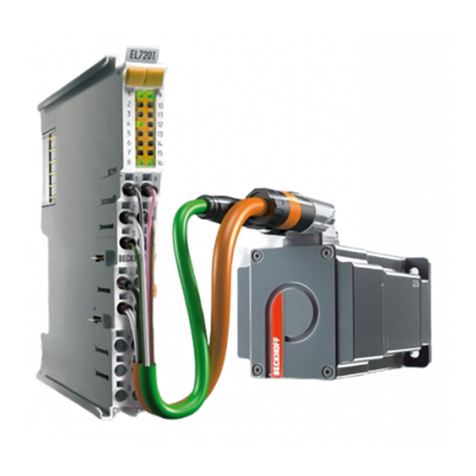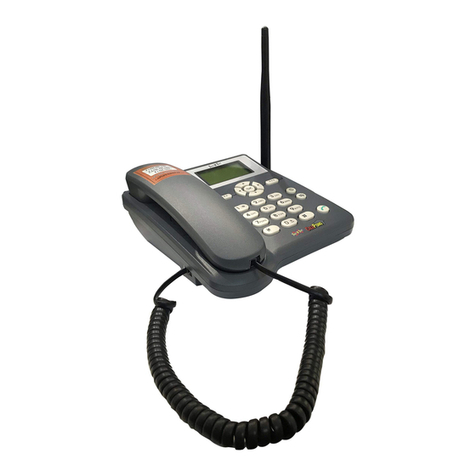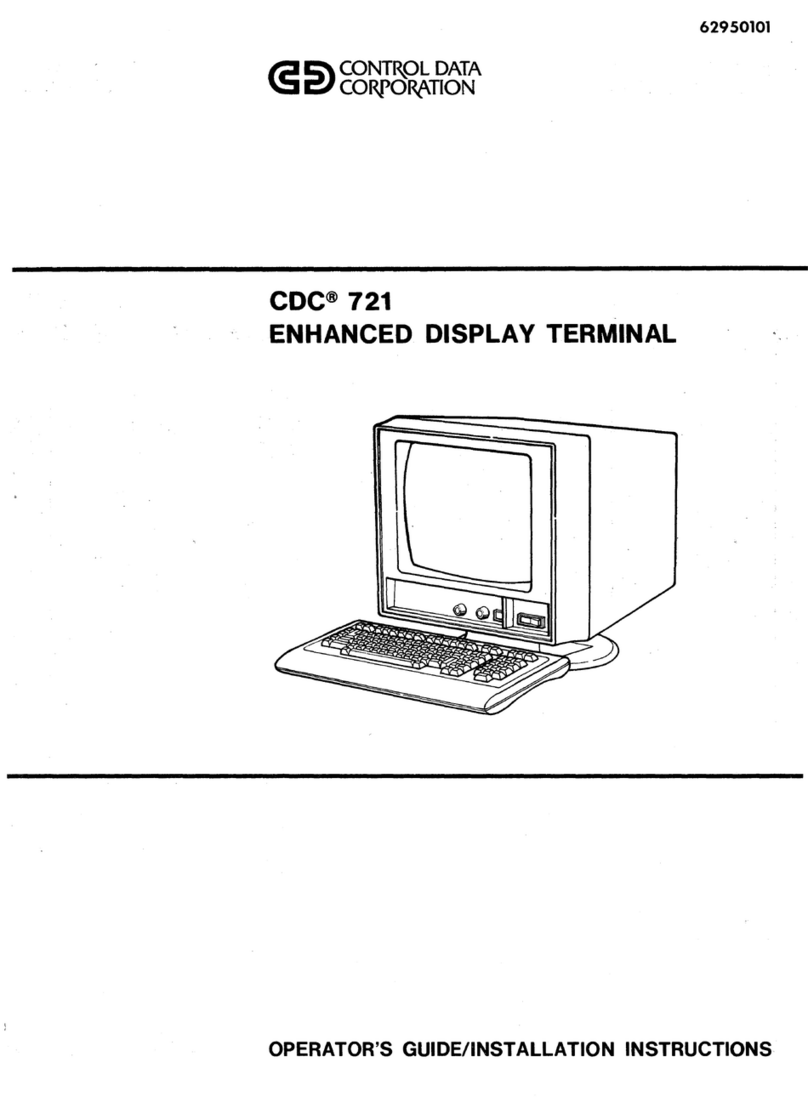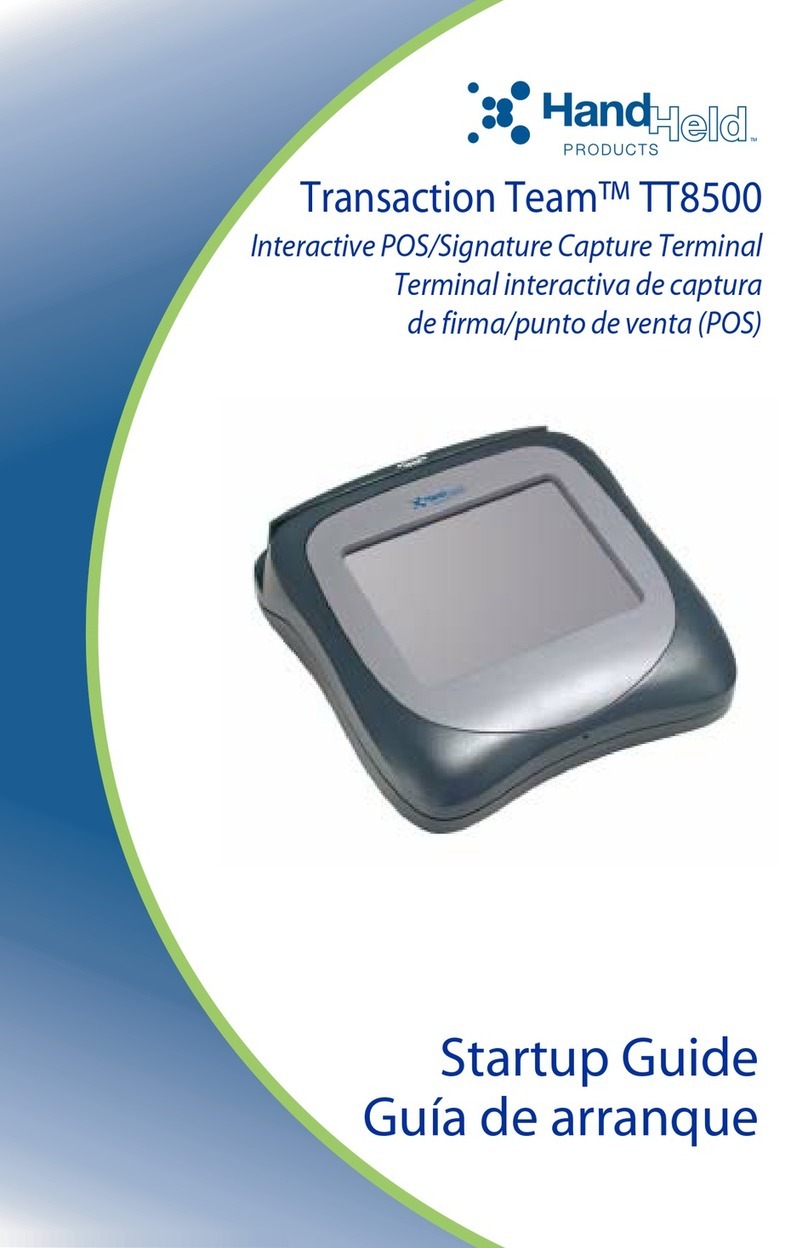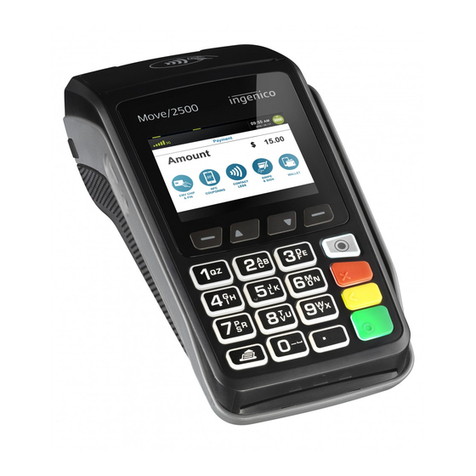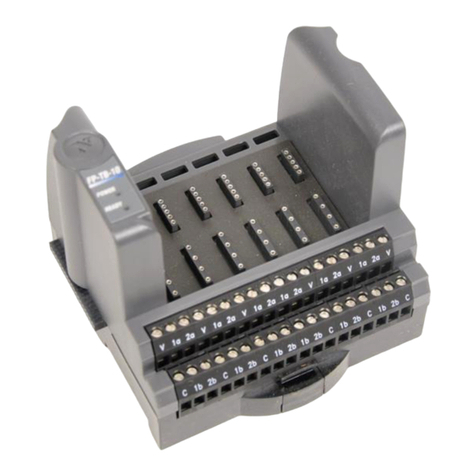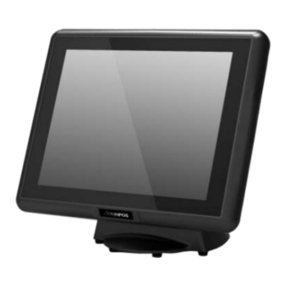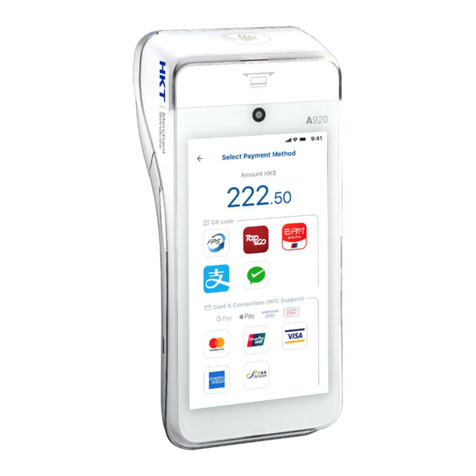Intecolor 2405 User manual

USER·S MANUAL
for
the
INTECOLOR
2495
TERMINAL
999378
10/16/83
V.-2.7
/
2.8

USERI S MANUAL
for
the
INTECOLOR
2405
TERMINAL
999378
10/16/83
V.-2.7/2.8
WARNING
This
equipment
generates,
uses,
and can
radiate
radio
frequency
energy
and
may
cause
interference
to
radio
communications
if
not
installed
and
used
in
accordance
with
the
instructions
in
this
manual.
The
equipment's
radio
frequency
emissions
have been
measured
and found
to
be
within
the
limits
established
in
FCC
Rules,
Part
15,
Subpart
J,
for
Class A computing
devices.
These
rules
are
designed
to
limit
interference
by
such
devices
to
levels
considered reasonable
for
commercial environments.
If
the
user
operates
this
equipment
in
a
residential
environment he
will
be
likely
to
cause
interference
for
which he can be
required
to
take
corrective
action
at
his
own
expense.
CCR
Intecolor
Corporation
225
Technology
Park/Atlanta
Norcross, Georgia 30092
Telephone: 404/449-5961
TWX:
810/766-1581
Copyright
(C)
1983
by
Intecolor
Corporation.
All
rights
reserved.

NOTICE
The
contents
of
this
publication
may
not
be reproduced
in
any
form
by
any
means
without
the
prior
written
consent
of
the
Intecolor
Corporation.
Neither
the
Intecolor
Corporation, nor
its
parent
company,
Intelligent
Systems
Corporation
assumes any
responsibility
for
errors
or
omissions
which
may
appear
in
this
document
or
any
liability
for
loss
or
damage
resulting
from
the
use
of
information
contained
in
it.
The
Intecolor
Corporation
reserves
the
right
to
revise
this
document and
to
make
changes
in
its
content
without
obligation
to
notify
any person
of
such
revisions
or
changes.
No
warranty
of
any kind
is
made
or
implied with regard
to
the
firmware
described
in
this
document and
to
its
merchantability
and
fitness
for
a
particular
purpose.
This firmware
is
furnished under a
license
agreement
and
may
be
used only
in
accordance
with
the
terms
of
the
agreement.
This
printing
of
the
2405 User I s Manual has
been
revised
to
cover
software
versions
up
to
and
including
V2.8.
To
report
errors
in
the
manual
or
software bugs,
please
complete and
return
the
Software Problem Report form
at
the
back
of
the
manual.
VT52™
is
a
trademark
of
Digital
Equipment
Corp.,
Maynard,
Massachusetts.
Copyright
(C)
1983
by
Intecolor
Corporation.
All
rights
reserved.

TABLE
OF
CONTENTS
PART
ONE: INTRODUCTION
TO
THE
2485
OVERVIEW
MODES
OF
OPERATION
DISPLAY
CAPABILITIES
Display
Organization
Character
Sets
Screen Saver
'mE
KEYBOARD
Special
Purpose
Keys
Alphanumeric
Keys
Keys
which Generate
ASCII
Control
Codes
Function
Keys
PF
(Private
Function)
Keys
Numeric
Keypad
Keys
Cursor
Control
Keys
TERMINAL
CONTROLS
AND
INDICATORS
Power
Switch and Line Fuse
Audible
Indicators
1.1
1.1
1.3
1.4
1.4
1.6
1.6
1.7
1.9
1.11
1.13
1.14
1.15
1.16
1.16
1.18
1.18
1.18
PART
'lWO:
INSTALLATION, INTERCONNECTION
AND
PatlER-UP
2.1
lllilPACKIN}
AND
INSPECI'ING
A
NEW
TERMINAL
'mE
OPERATI~
ENVIRONMENT
PCWER-UP
AND
PRELIMINARY
TESTING
Initial
Test
INTERCONNECTION
PART
THREE: SETUP, TESTING
AND
ON-LINE OPERATION
SETTING
UP
THE
TERMINAL
Items
on
the
Main
Setup
Menu
Summary
of
Terminal Setup Options
HOST-TERMINAL
COMMUNICATIONS
Software Handshaking
Terminal
Control
Codes
'mE
TERMINAL'S
SELF-TEST
CAPABILITIES
2.1
2.1
2.3
2.4
2.6
3.1
3.1
3.3
3.11
3.11
3.11
3.12
3.14

PART FOUR: OPERATION
IN
THE ANSI
X3.64
MODE
ANSI
CONl'ROL
SmUENCES
Command
Structure
Examples
of
Valid
ANSI
Sequences
A Note
on
Erroneous
Commands
ANSI
X3.
64
CavIMAND
SmUENCE
LISl'ING
PART
FIVE:
VT52
MODE
OPERATION
Ca-tMAND
SmUENCES
WHIOI
REPLACE
ANSI
SmUENCES
NEW
COMMAND
SmUENCES
ALTERNATE
KEY
CODES
APPENDICES
'!HE
ASCII
CODE
GLOSSARY
OF
TERMS
(ANSI)
TERMINAL
CONl'ROL
CODES
SUMMARY
OF
ANSI
SmUENCES
-
By
Mnemonic
SUMMARY
OF
ANSI
SmUENCES
-
By
Function
SUMMARY
OF
ANSI
SmUENCES
-
By
Code
TECHNICAL
SPECIFICATIONS
FOR
THE
24e5
LIGHT
PEN
OPERATION
SCHEMATIC
DIAGRAMS
24e5
Character
Set
Keyboard
CPU,
Program
Menory
and
I/O
Display
Memory
and Display Generator
Interconnecting
Wiring
Analog
Video Amplifiers
SOF'lWARE
PROBLEM
REPORT
4.1
4.1
4.1
4.2
4.3
4.5
5.1
5.1
5.2
5.2
A.l
B.l
C.l
D.l
E.l
F.l
G.l
H.l
le23e7
le1953
le1959,
sheet
1
le1959,
sheet
2
le1962
le1965
le1976

Figure
1.1
1.2
1.3
3.1
3.3
Table
1.4
1.5
1.6
1.7
1.8
1.9
1.10
2.1
2.2
2.3
2.4
3.2
3.4
4.1
Figures
in
the
Text
Description
Functional
Block Diagram
Display
Organization
Keyboard Layout
Main
Setup
Menu
Horizontal
Tabs
Tables
in
the
Text
Description
Alpha
Key
Codes
Numeric and
Punctuation
Key
Codes
Keyboard Generation
of
Control Codes
Default
Assignments
for
Function
Keys
PF
Key
Codes
Numeric
Keypad
Key
Codes
Cursor
Key
Codes
Keyboard Connector
Pin
Assignments.
Host Connector
Pin
Assignments
Printer
Connector
Pin
Assignments
Light
Pen
Connector
Pin
Assignments
Baud
Rates
Terminal Control Codes
PUl,
SS2
and
SS3
Sequences
1.2
1.5
1.8
3.2
3.8
~
loll
1.12
1.13
1.15
1.15
1.16
1.17
2.6
2.7
2.7
2.8
3.7
3.13
4.34-ff


PART
ONE


PART ONE: INTRODUCTION
TO
THE
2495
OVERVIEW
The
Intecolor
2405
is
a
data
terminal,
a device which an operator uses
to
communicate with a host computer and
to
control
auxiliary
equipment
like
printers
and
plotters.
Though
they
are
physically
unified,
the
2405's components have
two
logically
distinct
functions.
The
keyboard
acts
as
an
input
device
for
the
host
computer,
while
the
display
screen
acts
as
an output device
for
the
host
computer.
These two
devices
can
function
in
a
simultaneous
and
independent
fashion.
Data can be
transmitted
from
the
keyboard
to
the
host
while
different
data
are
transmitted
fram
the
host
to
the
display.
This
type
of
operation
is
called
full
duplex.
The 2405
belongs
among
those
terminals
which
are
popularly
characterized
as
"intelligent"
because they have camputing
capabilities
of
their
own. These
capabilities
are
provided by
microelectronic
devices,
in
particula~
by
large
scal~
integrated
circuits
which
function
as
processors
and
memor1es.
In
general,
the
presence
of
such
capabilities
at
the
terminal
is
doubly advantageous:
first,
because
the
host's
workload can be
minimized
(especially
important
in
time-sharing
situations);
second,
because
host
programming can be considerably
simplified.
The
2405's
computing
capabilities
allow
it
to
respond
to
commands
which
are
very
simple
in
form,
yet
require
very
complex
operations
for
their
execution.
The
operations
of
which
the
terminal
is
capable include
all
those
needed
to
construct
multicolored
displays
of
text
and/or graphs
from
data
supplied
according
to
either
of
two
protocols.
These
protocols
include
the
device
independent
and otherwise very
flexible
ANSI
Standard
X3.64
protocol,
and
the
widely used
DEC
VT52
protocol.
The
2405's
main
functional
elements
are
represented
in
the
diagram
on
the
next
page
(Figure
1.1).
Data
enter
and leave
the
terminal
in
serial
form
through
two
bidirectional
ports.
One
of
these
ports
is
used
for
the
keyboard and
for
a
printer.
The
other
is-used
for
the
host.
Within
the
terminal,
data
are
handled
eight
bits
in
parallel
by
a
microprocessor.
Associated
with
the
processor
is
a
read-only
program
memory
and a
read/write
Setup
memory, which
stores
the
values
defining
terminal
operating
conditions
such
as
baud
rate,
type
of
parity,
etc.
This
Copyright
(C)
1983
-1.1-
by
Inteco1or
Corporation

Introduction
memory
is
equipped
with
a
battery
which permits
it
to
remember
settings
between
operating
sessions.
The
processor
can
read
or
write
data
at
a
two
page
display
memory.
Data
fram
the
memory
is
used
by
a
display
generator
to
construct
video and
sync
signals.
The
video
signals
control
the
operation
of
three
electron
guns
in
the
CRT.
The
sync
signals
control
the
production
of
signals
which
deflect
the
electron
beams
produced
by
the
guns
to
produce a
raster
scan
of
the
display
screen.
(Further
information
about
display
capabilities
is
provided
on
the
following pages.)
HOST
PRINTER
KEYBOARD
Copyright
(C)
1983
INTECOLOR
2405
FUNCTIONAL BLOCK DIAGRAM
DATA
BUSS
BDI
-
BD7
CENTRAL
PROCESSING
UNIT
DISPLAY
MEMORY
REflESH
ORA
IROIf-IItOII
SYSTEM
ADDRESS
BUSS
BA'-
BAIS
DISPLAY
GENERATOR
+70V
+SV
+12V
-12V
LINE
SYNC
POWER SUPPLIES
AC
LINE
SYIIC ANALOG
UNIT
(Figure
1.1)
-1.2-
by
Inteco1or
Corporation

fv'DDES
OF
OPERATION
., Setup
Mode
e
ANSI
X3.
64
Mode
•
V'l52
Mode
•
Belf-test
Mode
Copyright
(C)
1983
Introduction
A
local
mode
of
operation,
entered
from
the
keyboard.
Used
to
select
the
values
of
parameters
governing
host/terminal
communications (baud
rate,
parity,
etc.)
and
other
operating
conditions,
and
to
check
status.
The
terminal's
display
unit
provides a Setup
Menu
representing
current
conditions.
Menu
items
are
selected
from
the
keyboard.
An
on-line
mode,
full
duplex,
with
selectable
local
echo,
entered
at
power-up
(when
the
terminal
is
appropriately
set
up),
from
Setup
Mode,
or
from
VT52
mode
upon
receipt
of
an
appropriate
command
from
the
keyboard
or
the
host.
The
terminal's
display
represents
a page
of
text
having
24
lines,
80
characters
per
line,
or
a
graphic
coordinate
system
with
limits
defined
by
the
points
(0,0) and (159,
95).
An
on-line
mode,
full
duplex,
with
selectable
local
echo,
entered
at
power-up
(when
the
terminal
is
appropriately
set
up),
from
Setup
Mode
or
fram
ANSI
Mode
following
receipt
of
an
appropriate
command
from
the
keyboard
or
host.
Display
capabilities
are
the
same
as
those
for
ANSI
Mode.
A
local
mode,
entered
automatically
at
terminal
power-up and
upon
the
receipt
of
an
appropriate
command
from
the
keyboard
or
host.
The
screen
is
used
to
display
test
patterns
and
error
messages.
When
no
error
is
found,
the
terminal
reverts
automatically
to
one
of
its
other
modes.
-1.3-
by
Inteco1or
Corporation

Introduction
DISPLAY
CAPABILITIES
The
method used
to
create
displays
involves
the
electronic
division
of
the
display
area
on
the
screen
to
form a
matrix
of
cells
in
which
characters
or
plot
blocks can be
represented.
Display
Organization
The
dimensions
of
the
character
cell
matrix
are
80
character
cells
horizontally
and
24
character
cells
vertically.
Accordingly,
the
display
area
can
represent
a page
of
text
having
24
lines,
each
line
having
up
to
80
characters.
In
graphic
displays,
each
character
cell
represents
some
combination
of
up
to
8
plot
blocks.
A
graph
is
constructed
of
plot
blocks
on
an
(x,y)
coordinate
system
in
which x
is
an
integer
between
0
and
159
and y
is
an
integer
between
0
and 95.
Each
character
cell
resolves
to
a 6 x 12
pixel
matrix,
in
which
characters
and
plot
blocks
are
represented
as
patterns
of
colored
dots.
Each
character
cell
as
a whole
is
treated
as
an element
of
the
display.
A
memory
register
is
assigned
to
each
character
cell,
whose
content
is
defined
by
a
data
word
written
into
the
associated
register.
The
address
of
each
memory
register
corresponds
to
the
position
of
a
character
cell
in
the
display
area,
and
the
memory
furnishes
the
standard
resolution
display
generator
with
a sequence
of
data
words
in
step
with
the
progress
of
the
sweep
of
the
CRT's beams from
cell
to
cell
over
the
screen.
The
data
words
stored
in
the
memory
array
define
the
contents
of
the
character
cells
in
two
ways.
On
the
one hand, they
single
out
characters
from
the
terminal's
character
set
or
plot
block
set.
On
the
other
hand,
they
determine
a background
combination
for
the
display
of
the
selected
character
the
blink
or
underscore
attribute
of
the
character.
eight
foreground
colors
are
displayable.
and foreground
color
or
plot
block(s)
and
Eight
background and
The
data
words
held
in
memory do
not
represent
directly
the
dot
patterns
and
dot
colors
which
represent
characters
and
plot
block groups.
Instead,
they
point
to
registers
in
read-only
memories where a code
for
each
displayable
character
and
color
combination
is
permanently
stored.
Accordingly,
when
the
contents
of
the
standary
resolution
display
memory
are
changed,
the
content
of
an
entire
character
cell,
i.e.,
a
character
and/or
color,
is
changed.
Color
control
is
possible
with
ANSI
sequences and
with
the
FG/BG
key,
used
in
combination
with
keys
Q,
W,
E,
R,
T,
Y,
U
and
I.
(See
the
SGR
sequences
described
in
Part
Four
and
the
keyboard
description
below
for
further
information.)
The
size
of
the
2405's
character
cell
matrices
permits
the
display
of
the
ASCII
characters
with
standard
resolution
and,
in
addition,
the
display
Copyright
(C)
1983
-1.4-
by
Inteco1or
Corporation

Introduction
Display
Organization
(Figure
1.2)
r--
80
CHAR
SPACES
(480
DOTS)
I
I}
....
",
..............
\,',
............
l
24
ROWS
OF
CHAR
SPACES
(288
DOTS)
\'"
......
'"
...
\ "
ggg
--,
J
\ "
f=.0,:.;oo=+--I
I
\ ,
\ 12
\
t---t--t
DOTS
~------------~~
~+-------~
\ \
~D~TS-l
25
TH
CHAR
SPACE
ON
THE 11TH
ROW
DISPLAY
OF THE
LETTER
aT·
IN
THIS
SPACE ·DISPLAY
OF
A PLDTTING BLDCK
(49,54)
IN
THIS
SPACE
000
000
000
000
0
••
•••
000
.00
000
.00
000
.00
000
.00
000
.00
000
.00
000
000
000
000
000
000
Copyright
eC)
1983
• FOREGROUND
COLOR
a BACKGROUND
COLOR
-1.5-
000
000
000
000
000
000
000000
000
000
000
000
•••
000
•••
000
•••
000
000
000
000
000
000
000
by
Inteco1or
Corporation

Introduction
of
those
lower
case
characters
which have
descenders
in
their
proper
relations
to
the
other
characters.
Character
Sets
The
character
set
includes
the
96
uppercase
and
lowercase
ASCII
characters,
32
control
code symbols and
32
special
graphics
characters.
The
complete
character
set
is
represented
on a
fold-out
chart
(drawing
#102307)
included
in
the
appendices.
The
control
code symbols
are
displayable
only following
the
issuance
of
a
special
ANSI
control
sequence.
When
the
terminal
is
in
the
Control
Representation
Mode
both
ASCII
control
codes and longer
control
sequences
are
represented
on
the
screen,
but
these
codes
and
sequences
are
not
otherwise
acted
on
by
the
terminal
processor.
(See
the
CRM
sequences.)
Switching
between
the
ASCII
lowercase
characters
and
the
special
graphics
characters
is
done
in
response
to
<so>
and
<SI>
control
codes,
issued
by
the
host
or
fran
the keyboard
(when
local
echo
is
selected).
The
ASCII
uppercase
characters
are
always
available.
(See
the
ANSI
SCS
sequences
for
fUrther information.)
Graphs
constructed
of
plot
blocks can be
displayed
in
response
to
ANSI
command
sequences which cause
points
and
lines
to
be drawn. (See
the
PIO'I'
cOI11!Pands.)
Plot
blocks
resolve
to
3 x 3
dots,
and
there
can be
up
to
eight
blocks
in
a
character
cell.
Blocks can be
plotted
one
at
a time,
but
they
are
handled
by
the
display
generator
as
groups
of
one
to
eight,
like
characters.
Accordin91y,
when a
new
block
is
to
be displayed
within
a
given
character
cell,
the
contents
of
the
entire
cell
are
changed. For
example,
if
a group of
two
blocks
is
already
displayed
in
the
9iven
cell
it
is
replaced
with
a
group
of
three
blocks
having
the
proper
positions
relative
to
one another. This
means
that
the
colors
of the blocks
are
not
indepentently
controllable.
The 2405
contains
two
memory
arrays
which
are
dedicated
to
character
cell
graphics;
each
array
can
hold
enough
data
to
define
one complete
display.
Normally, one page
of
memory
is
used
for
the
Setup
Mode
menu
and
the
other
is
used
for
normal
display;
accordingly, switching
to
Setup
Mode
does not involve
the
loss
of
data.
Screen
Saver
A
CRT
(cathode
ray
tube) such
as
that
used
in
the
2405
is
subject
to
damage by
the
prolonged
display
of
a
fixed
image on
its
screen.
Such
display
tends
to
"burn"
the
image
into
the
screen's
phosphors.
The 2405
has
automatic
equipment which
is
designed
to
prevent
this
kind
of
damage
and thereby prolong
the
life
of
the
CRT
by
limiting
the
time
a
given
image can be
displayed
on
the
screen.
A
display
which
is
not
changed
within
a
period
of
ten
minutes
is
automatically
turned
off.
The
display
returns
as
soon
as
there
is
any
activity
from
the
host
or
keyboard.
Copyright
(C)
1983
-1.6-
by
Inteco1or
Corporation

Introduction
The
screen
saver
equipment
may
be
enabled
or
disabled
by
means
of
Setup
Mode
commands.
THE
KEYBOARD
The
keyboard
is
used
to
generate codes which
are
transmitted
either
to
the
host
computer
alone
(on-line
operation
with
no
local
echo),
to
the
display
unit
alone
(off-line
or
local
operation),
or
to
both
host
and
display
unit
(on-line
operation
with
local
echo). These codes
are
ASCII
binary
equivalents
of
characters
and
control
symbols or of groups
of
these
characters
and
control
symbols.
Within
the
terminal,
the
keyboard
is
assigned
a
buffer
where
keystrokes
are
recorded
until
the proper codes can be generated and
sent
to
the
host
computer.
If
the
processing of keystrokes
is
slowed
down
or
held
up
while
the
operator
continues
typing,
the
buffer
can
fill
up.
If
this
occurs,
an
audible
indication
is
given each time a
new
key
is
pressed
and
the
keystroke
is
ignored.
When
the
terminal has had time
to
process
some
of
the
keystrokes
in
the
buffer
new
keystrokes
are
again
accepted. A
buffer
overflow
is
very
unlikely
to
occur unless the Repeat
key
is
held
down.
The
standard
2405
keyboard
is
built
in
to
the
cabinet
and
is
connected
to
the
terminal
electronics
by a
cable
and telephone type plug which
is
accessible
from
the
rear
of
the
unit.
The
2405D
has a detatched keyboard
which
is
connected
to
the
terminal
with a
coiled
cable
terminated with a
standard
telephone type plug.
To
insure
proper
operation,
the
keyboard
cable
should
be
securely
plugged
into
the
terminal
before
power
is
applied.
If
the
cable
plugged
in
while
the
terminal
is
under
power
the
keyboard might not
operate
properly.
Several
versions
of
the
keyboard
are
available.
These
versions
differ
mainly
with
respect
to
the
number of programmable
function
keys (F0-F23)
installed
and
to
the
keys
assigned
color
control
functions.
Keyboards
supplied
with
terminals
having
V2.l
through
V2.4
software
have
either
twelve
or
twenty-four
function
keys,
of
which
the
first
seven
are
marked
with
color
codes and
are
used
in
conjunction with
the
BG/F
key
for
display
color
control.
Keyboards supplied with
terminals
having V2.5 through
V2.7
software have color codes
on
alphabetic
keys Q through I and
may
have
zero,
twelve
or
twenty-four
function
keys.
The
keys
are
arranged
in
three
major groups.
The
group
of
keys
to
the
operator's
right
is
used
to
control
the
display
cursor,
a
blinking
line
or
other
visible
sign
which marks
the
position
at
which
the
next
display
operation
will
begin.
Copyright
(C)
1983
-1.7-
by
Inteco1or
Corporation

Introduction
24B5 Keyboard Layout
(Figure
1.3)
NUMERIC
PAD
OJRSOR
PAD
The
keys
grouped
immediately
to
the
left
of
the
cursor
pad
are
arranged
in
six
rows. The
top
two rows
contain
special
purpose keys
who~e
functions
are
discussed.below.
The
bottom
four
rows
constitute
a numenc
keypad
similar
to
those
found on
standard
office
machines.
The
main
keypad
includes
alphabetic
and numberic keys
organized
like
the
keys
on a
standard
typewriter.
These
keys
have
grey
caps.
When
installed,
the
programmable
function
keys
are
situated
above
the
alphanumeric
keys
iiI
one
or
two
rows.
Many
of
the
ranaining
keys have
special
functions
which
are
described
below.
The
functions
of
the'
various
keys ·on
the
keyboard
are
described
on
the
following
pages
in
detail
under
the
following
headings:
•
Special
Purpose Keys
o
The
Alphanumeric Keys
in
the
Main
Keypad
• Keys Which Generate
ASCII
Control
Codes
•
Function
Keys
(F0
-
F23)
•
PF(Private
Function)
Keys
• Numeric Keypad Keys
• Cursor
Control
Keys
Copyright
(C)
1983
-1.8-
by
Intecolor
Corporation

Special
Purpose Keys
D
COMMAND
lJ
~
~
Introduction
The
Setup
key
is
operated while holding
down
either
of
the
Shift
keys
in
order
to
place
the
ter~minal
in
its
Setup
Mode
or
to
take
it
out
of
this
mode.
This
key
is
used
by
itself
to
enable
operation
of
the
keyboard
when
it
has been
disabled
by
a
command
from
the
host
or
by
the
terminal's
Self-test
prograrn.
This key never
transmits
a code
to
the
host.
When
the
Break key
is
operated,
the
transmission
line
to
the
host
is
pulled
to
a
logical
low
state
for
0.2333
seconds
(with
a
ten-percent
variation)
and any
operation
being
performed
by
the
terminal
processor
(scrolling
the
display,
for
example)
is
interrupted.
The
operation
of
this
key
has
no
effect
when
the
keyboard has been
disabled.
The
Command
Key
is
used
in
conjunction
the
alphanumeric
keys
to
generate
Escape sequences
that
may
be
assigned
functions
by
the
host
program.
The
key
is
used
by
holding
it
down
while
striking
another
key.
When
operated
by
itself
it
generates
no
code.
The
sequences
generated
when
this
key
is
used begin
with
<ESC>O.
For example, the combination
(Comn~d
P)
gives
the
following sequence:
<ESC>OP
The Page
Print
key
is
used
to
transfer
the
contents
of
a
display
to
a
printer
without
altering
the
display.
It
sends
the
following
Media
Copy
(MC)
command
sequence:
<ESC>[0i
This
key
can
be used
when
the
terminal
is
operating
in
any
mode.
Copyright
(e)
1983
-1.9-
by
Intecolor
Corporation

copyright
(C)
1983
Introduction
The
Erase
Line
key
is
used
to
erase
the
<contents
of
the
display
from
the
cursor
position
to
the
end
of
the
line.
It
sends
the
following
Erase Line
(EL)
command
sequence:
<ESC>[0K
This
key
can
be
used
only
when
the
terminal
is
operating
in
the
ANSI
X3.64
Mode
(local
or remote
echo enabled).
The
Erase
Page
key
is
used
to
erase
the
display
from
the
cursor
position
to
the end of
the
page.
The
key
generates
the
following
Erase DisFlay
(ED)
command
seauence:
<ESC>[0J
This
key can be
used
only
when
the
terminal
is
operating
in
the
ANSI
X3.64
Mode
(local
er
rerrote
echo enabled).
The
FG/BG
key
is
used
to
change
the
colers
with
which
characters
and
plot
blocks
are
displayed.
Color
change
is
accomplished
by
striking
this
key
and
then
one
of
the
following
alphabetic
keys:
Q,W,E,R,T,Y,U,I
(or,
in
some
units,
keys F0-F7).
These keys
represent
the
colors
black,
red,
green,
yellow,
blue,
magenta, cyan,
and
white
respectively.
Only
characters
displayed subsequently, beginrling
at
the
current
cursor
position
are
affected.
Used
unshifted
with one
of
the
color coded keys,
the
FG/BG
generates an
ANSI
SGR
foreground
coler
control
sequence.
Shifted,
FG/BG
generates
an
ANSI
SGR
background
color
control
sequence.
When
the
tenninal
is
on
line
the
SGR
sequences must be echoed
locally
or
by
the
host
before
they
can
be
acted
upon.
The
Repeat
key
may
be
held
down
together
with
another
key
in
order
to
transmit
repeatedly
the
code
or code sequence generated
by
that
key.
If
this
key
is
used
to
generate a very long
string
of
codes
while
the
terminal
is
operating
at
a
low
baud
rate
the··
keyboard
buffer
could
overflow.
Therefore,
the
terminal
is
equipped with a
repeat
rate
controller,
which
lowers
the
repeat
rate
automatically
if
the
buffer
fills
to
a
certain
point.
(See
the
PRKC
ccmnands.)
-1.10
.....
by
InteeoloJ:
Corpora,tion

Introduction
The Alphanumeric Keys
in
the
Main
Keypad
The
alphanumeric
keys
(including
the
space
bar),
with
grey
caps,
generate
the
ASCII
codes
for
the
uppercase
and
lowercase
alphabetic
characters,
numerals and
punctuation
marks.
When
these
codes
are
returned
to
the
terminal,
either
locally
or
by
the
host,
they can cause
the
display
of
the
characters.
In
certain
modes
of
operation,
these
keys can be used
to
display
special
graphics
characters.
On
some
terminals
the
keys
Q,
W,
E,
R,
T,
Y,
U and I
are
marked
with
colored
bars.
(Others have
colored
bars
on
the
function
keys F0-F7.)
The
color
coded keys can be used
in
conjunction
with
the
FG/BG
key
to
generate
ANSI
SGR
sequences
for
changing
the
colors
of
the
display.
Operated
by
themselves,
the
alphanumeric keys
generate
the
lowercase
A~CII
codes.
They
are
commonly
used
in
conjunction
with
three
other
keys,
the
two
Shift
keys and
the
Alpha
Lock
key,
to
produce
the
uppercase codes.
The
two
Shift
keys
are
used
interchangeably
in
conjunction
with
other
keys
to
generate
the
uppercase
ASCII
codes.
All
the
alphanumeric keys
except
for
the
Space Bar and
DEL
are
affected
by
the
Shift
keys.
The
Shift
keys
are
used
by
holding
either
of
them
down
while
operating
another
key.
By
themselves they
generate
no
code.
The Alpha Lock
key,
when
engaged,
makes
all
the
alphabetic
keys
uppercase.
It
does
not
affect
numeric and
special
character
keys.
The
codes
generated
with
the
alphabetic
keys
are
given
in
the
table
below
as
hexadecimal numbers.
Alpha
Key
Codes -(Table
1.4)
~
Shifted
Unshifted
~
Shifted
Unshifted
A
41
61
N
4E
6E
B
42
62
0
4F
6F
C
43
63
P
50
7'0
D
44
64
Q
51
71
E
45
65
R
52
72
F
46
66
S
53
73
G
47
67
T
54
74
H
48
68
U
55
75
I
49
69
V
56
76
J
4A
6A
W
57
77
K
4B
6B
X
58
78
L
4C
6C
y
59
79
M
4D
6D
Z
SA
71',
Copyright
(C)
1983
-1.11..,. by
Intecolor
Corporation
Table of contents
